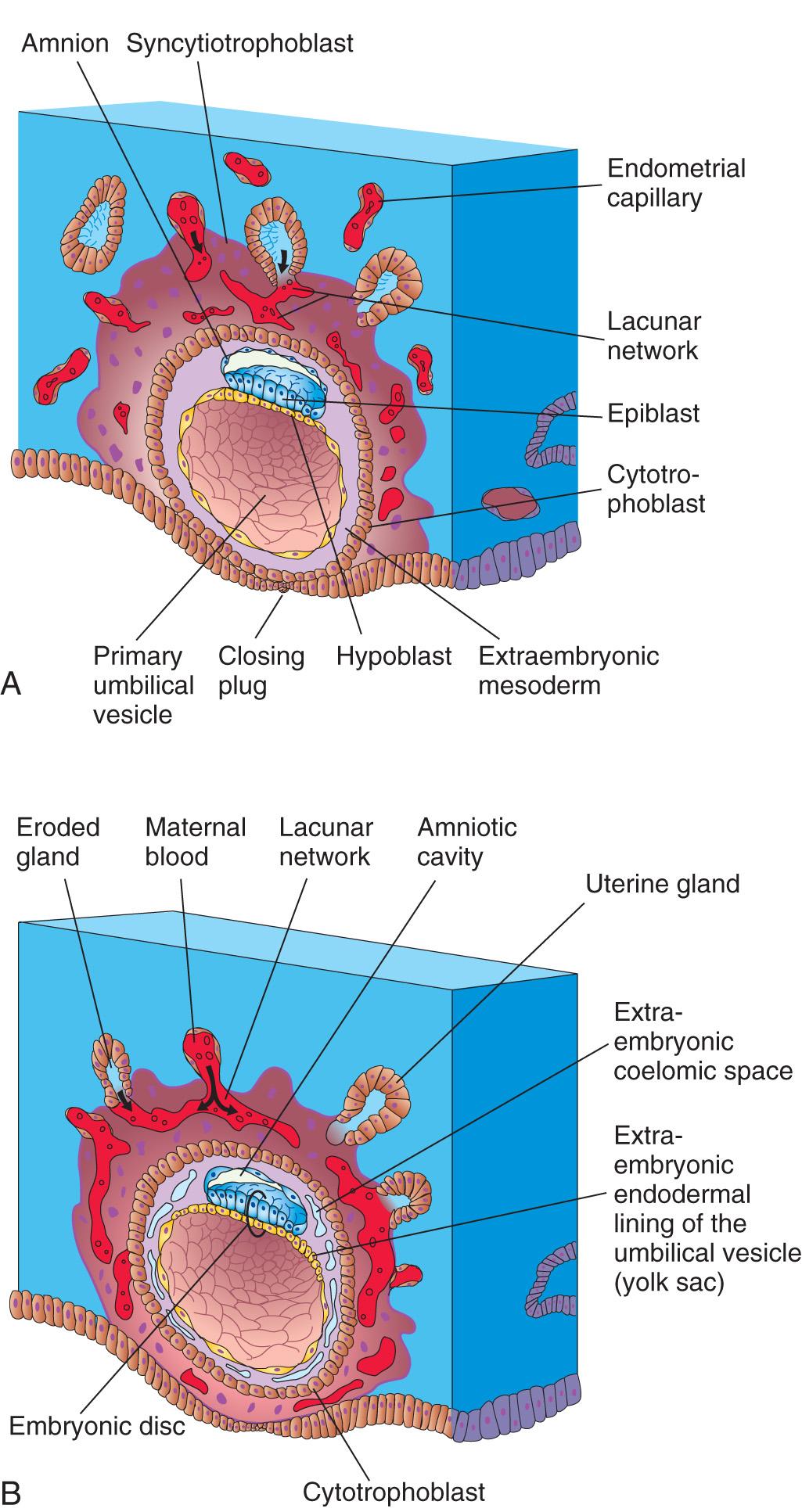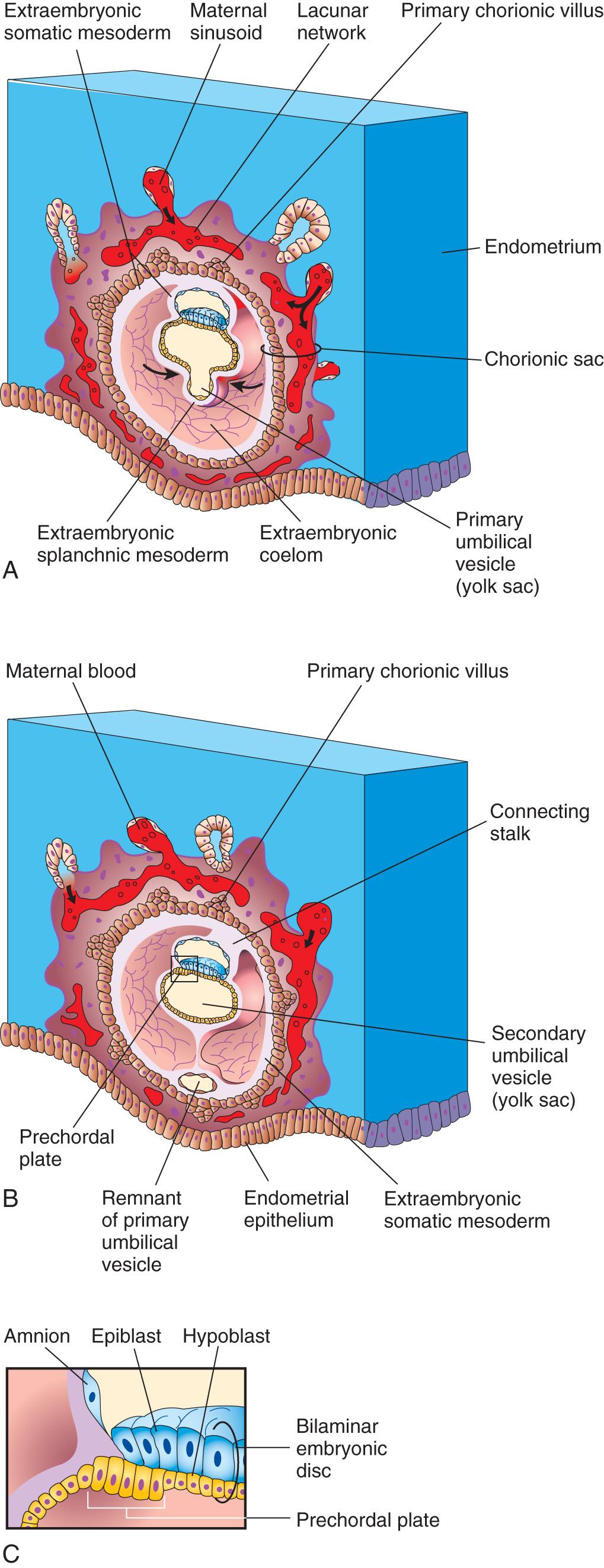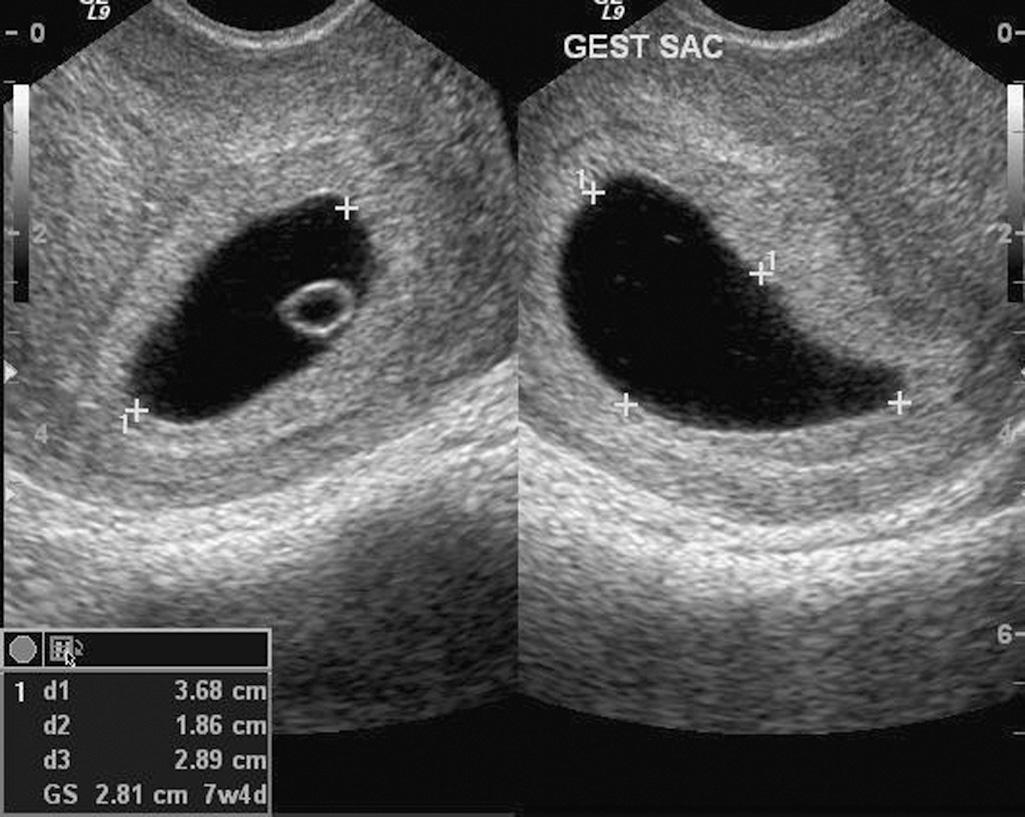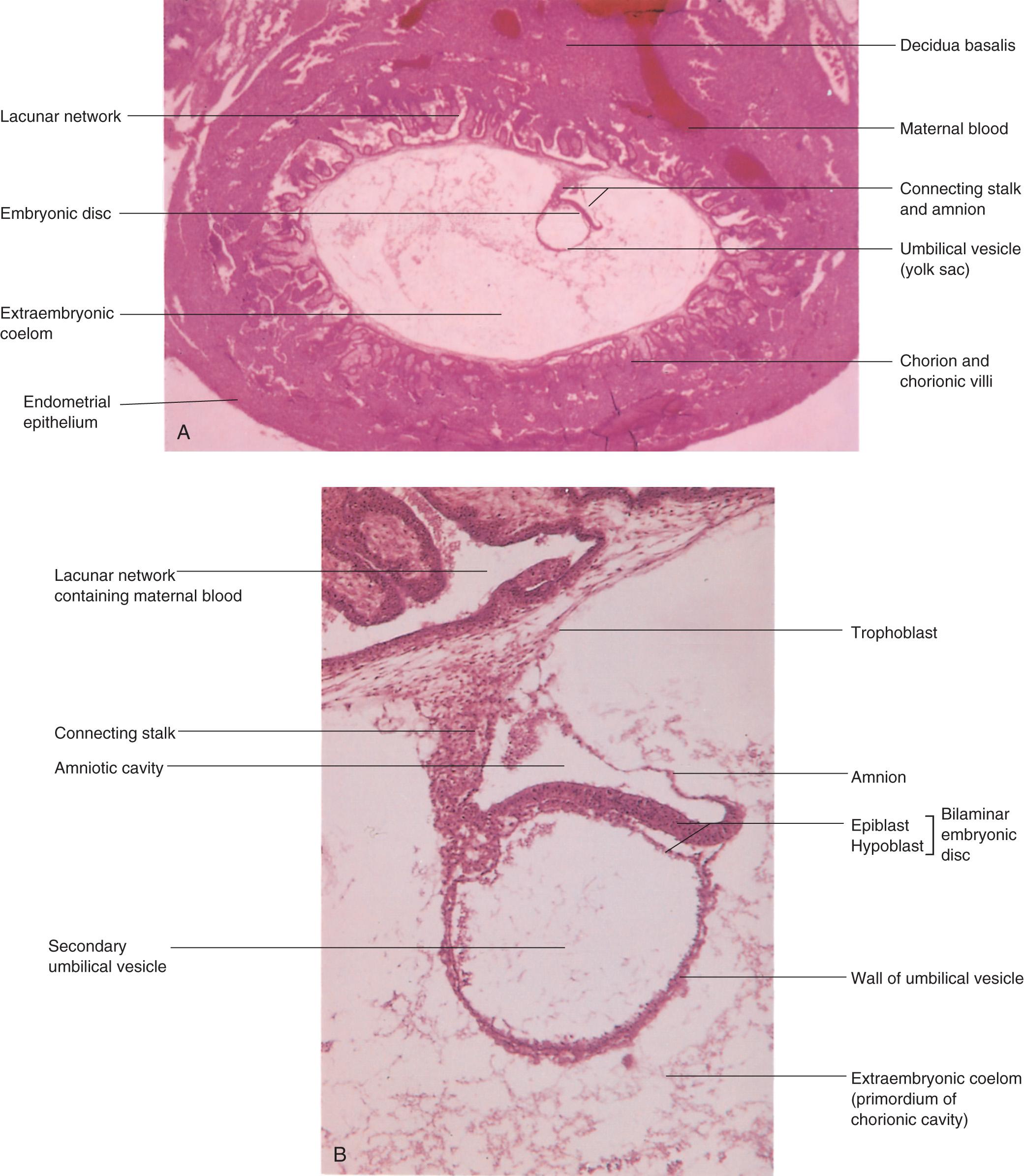Physical Address
304 North Cardinal St.
Dorchester Center, MA 02124
As implantation of the blastocyst occurs, morphologic changes in the embryoblast produce a bilaminar embryonic disc composed of epiblast and hypoblast ( Fig. 3.1 A ). The embryonic disc gives rise to the germ layers that form all the tissues and organs of the embryo. Extraembryonic structures forming during the second week are the amniotic cavity, amnion, umbilical vesicle connecting stalk, and chorionic sac.
Implantation of the blastocyst is completed during the second week. It occurs during a restricted time period 6 to 10 days after ovulation and fertilization. As the blastocyst implants (see Fig. 3.1 ), more trophoblast contacts the endometrium and differentiates into two layers:
An inner layer, the cytotrophoblast, that is mitotically active (i.e., mitotic figures are visible) and forms new mononuclear cells that migrate into the increasing mass of syncytiotrophoblast, where they fuse and lose their cell membranes; trophoblast fusion is regulated by the cyclic adenosine monophosphate (AMP) pathway
The syncytiotrophoblast, a rapidly expanding, multinucleated mass in which no cell boundaries are discernible
The syncytiotrophoblast enters the endometrial connective tissue through the process of interstitial invasion, and the blastocyst slowly becomes embedded in the endometrium, which ceases to proliferate ( Fig. 3.2 ). Syncytiotrophoblastic cells displace endometrial cells at the implantation site. The endometrial cells undergo apoptosis (programmed cell death), which facilitates the invasion.

The molecular mechanisms of implantation involve synchronization between the invading blastocyst and a receptive endometrium. The window of implantation is relatively brief, 2 to 3 days, during which bone morphogenetic proteins (BMPs) are expressed in the endometrium and are essential for fertilization. The microvilli of endometrial cells, cell adhesion molecules (integrins), cytokines, prostaglandins, hormones (human chorionic gonadotropin [hCG] and progesterone), growth factors, cell – cell and cell – extracellular matrix communication enzymes (matrix metalloproteinase and protein kinase A) , and Wnt signaling pathways play a role in making the endometrium receptive. In addition, the endometrial cells help to modulate the depth of penetration of the syncytiotrophoblast. The process of invasion reaches a maximum at 9 to 12 weeks.
The connective tissue cells around the implantation site accumulate glycogen and lipids and assume a polyhedral (many-sided) appearance. Some of these cells, decidual cells, degenerate adjacent to the penetrating syncytiotrophoblast. The syncytiotrophoblast engulfs these cells, providing a rich source of embryonic nutrition. The syncytiotrophoblast produces a glycoprotein hormone, hCG , which enters the maternal blood via isolated cavities (lacunae) in the syncytiotrophoblast (see Fig. 3.1 B ); hCG maintains the hormonal activity of the corpus luteum in the ovary during pregnancy. The corpus luteum is an endocrine glandular structure that secretes estrogen and progesterone to maintain pregnancy (see Chapter 2 , Fig. 2.11 ). Highly sensitive radioimmunoassays are available for detecting hCG, and they form the basis for pregnancy tests. Enough hCG is produced by the syncytiotrophoblast at the end of the second week to give a positive pregnancy test, even though the woman is probably unaware that she may be pregnant.
2
As implantation of the blastocyst progresses, a small space appears in the embryoblast, which is the primordium of the amniotic cavity (see Figs. 3.1 A and 3.2 B ). Soon, amniogenic (amnion-forming) cells, amnioblasts , separate from the epiblast and form the amnion , which encloses the amniotic cavity. Concurrently, morphologic changes occur in the embryoblast (cluster of cells from which the embryo develops) that result in the formation of a flat, almost circular bilaminar plate of cells, the embryonic disc , consisting of two layers (see Fig. 3.2 A and B ):
Epiblast , the thicker layer, consisting of high columnar cells related to the amniotic cavity
Hypoblast , consisting of small cuboidal cells adjacent to the exocoelomic cavity
The pluripotent epiblast forms the floor of the amniotic cavity and is continuous peripherally with the amnion. The hypoblast forms the roof of the exocoelomic cavity (see Fig. 3.1 A ) and is continuous with the thin exocoelomic membrane . This membrane, together with the hypoblast, lines the primary umbilical vesicle . The embryonic disc now lies between the amniotic cavity and vesicle (see Fig. 3.1 B ). Cells from the vesicle endoderm form a layer of connective tissue, the extraembryonic mesoderm (see Fig. 3.2 A ), which surrounds the amnion and umbilical vesicle. This vesicle and amniotic cavity make morphogenetic movements of the cells of the embryonic disc possible.
As the amnion, embryonic disc, and umbilical vesicle form, lacunae (small spaces) appear in the syncytiotrophoblast (see Figs. 3.1 A and 3.2 ). The lacunae become filled with a mixture of maternal blood from ruptured endometrial capillaries and cellular debris from eroded uterine glands (see Chapter 2 , Fig. 2.6 C ). The fluid in the lacunar spaces, embryotroph , passes to the embryonic disc by diffusion and provides nutritive material to the embryo.
The communication of the eroded endometrial capillaries with the lacunae in the syncytiotrophoblast establishes the primordial uteroplacental circulation . When maternal blood flows into the lacunar networks (see Fig. 3.2 A and B ), oxygen and nutritive substances pass to the embryo. Oxygenated blood passes into the lacunae from the spiral endometrial arteries (see Chapter 2 , Fig. 2.6 C ), and poorly oxygenated blood is removed from them through the endometrial veins.
The 10-day conceptus is completely embedded in the uterine endometrium (see Fig. 3.2 A ). Initially, there is a surface defect in the endometrial epithelium that is soon closed by a closing plug of a fibrin coagulum of blood (see Fig. 3.2 A ). By day 12, an almost completely regenerated uterine epithelium covers the closing plug ( Fig. 3.3 , and see Fig. 3.2 B ). This partially results from signaling by cyclic adenosine monophosphate and progesterone. As the conceptus implants, the endometrial connective tissue cells continue to undergo a transformation, the decidual reaction . The cells swell because of the accumulation of glycogen and lipid in their cytoplasm. The primary function of the decidual reaction is to provide nutrition for the early embryo and an immunologically privileged site for the conceptus.

In a 12-day embryo , adjacent syncytiotrophoblastic lacunae (small spaces) have fused to form lacunar networks ( Fig. 3.4 B , and see Fig. 3.2 B ), giving the syncytiotrophoblast a sponge-like appearance. The networks, particularly obvious around the embryonic pole, are the primordia of the intervillous spaces of the placenta (see Chapter 7 , Fig. 7.5 ). The endometrial capillaries around the implanted embryo become congested and dilated to form maternal sinusoids , thin-walled terminal vessels that are larger than ordinary capillaries ( Fig. 3.5 A ). The formation of blood vessels in the endometrial stroma (framework of connective tissue) is under the influence of estrogen and progesterone. Expression of connexin 43 (Cx43), a gap junction protein, plays a critical role in angiogenesis at the implantation site and in the maintenance of pregnancy.


The syncytiotrophoblast erodes the sinusoids, and maternal blood flows freely into the lacunar networks (see Figs. 3.4 B and 3.7 B ). The trophoblast absorbs nutritive fluid from the lacunar networks, which is transferred to the embryo. Growth of the bilaminar embryonic disc is slow compared with growth of the trophoblast (see Figs. 3.1, 3.2, and 3.7 B ). The implanted 12-day embryo produces a minute elevation on the endometrial surface that protrudes into the uterine cavity (see Figs. 3.3 and 3.4 ).
As changes occur in the trophoblast and endometrium, the extraembryonic mesoderm increases and isolated extraembryonic coelomic spaces appear within it (see Figs. 3.2 B and 3.4 B ). These spaces rapidly fuse to form a large isolated cavity, the extraembryonic coelom (see Fig. 3.5 A ). This fluid-filled cavity surrounds the amnion and umbilical vesicle, except where they are attached to the chorion (outermost fetal membrane) by the connecting stalk (see Fig. 3.7 A and B ). As the extraembryonic coelom forms, the primary umbilical vesicle decreases in size, and a smaller secondary umbilical vesicle forms (see Fig. 3.5 B ). (The term umbilical vesicle is preferred because the yolk sac does not contain yolk in humans.) This smaller vesicle is formed by extraembryonic endodermal cells that migrate from the hypoblast inside the primary umbilical vesicle ( Fig. 3.5 C ). During formation of the secondary umbilical vesicle, a large part of the primary umbilical vesicle is pinched off, leaving a remnant of the vesicle (see Fig. 3.5 B ). Although the umbilical vesicle in humans contains no yolk; it has important functions—for example, it is the site of origin of primordial germ cells (see Chapter 12 ). It may also have a role in the selective processing and transfer of nutrients from the coelomic cavity to the embryonic disc.
2
The end of the second week is characterized by the appearance of primary chorionic villi (see Fig. 3.5 A and B ). The villi (vascular processes of the chorion) form columns with syncytial coverings. The cellular extensions grow into the syncytiotrophoblast. The growth of these extensions is thought to be induced by the underlying extraembryonic somatic mesoderm . The cellular projections form primary chorionic villi (see Fig. 3.5 A and B ), the first stage in the development of the chorionic villi of the placenta (fetomaternal organ of metabolic interchange between the embryo and mother).
The extraembryonic coelom splits the extraembryonic mesoderm into two layers (see Fig. 3.5 A and B ):
Extraembryonic somatic mesoderm, lining the trophoblast and covering the amnion
Extraembryonic splanchnic mesoderm, surrounding the umbilical vesicle
The extraembryonic somatic mesoderm and the two layers of trophoblast form the chorion, which forms the wall of the chorionic sac (see Fig. 3.5 A and B ). The embryo, amniotic sac, and umbilical vesicle are suspended in this sac by the connecting stalk. The extraembryonic coelom is the primordium of the chorionic cavity .
Transvaginal ultrasonography (endovaginal sonography) is used for measuring the diameter of the chorionic sac ( Fig. 3.6 ). This measurement is valuable for evaluating early embryonic development and pregnancy outcome.

A 14-day embryo still has the form of a flat bilaminar embryonic disc ( Fig. 3.7 B , and see Fig. 3.5 C ), but the hypoblastic cells in a localized area are now columnar and form a thickened circular area, the prechordal plate (see Fig. 3.5 B and C ). This plate indicates the site of the mouth and is an important organizer of the head region.

3
Implantation of blastocysts usually occurs in the uterine endometrium in the superior part of the body of the uterus, slightly more often on the posterior wall than on the anterior wall of the uterus (see Fig. 3.9 ). Implantation of a blastocyst can be detected by ultrasonography and highly sensitive radioimmunoassays of hCG as early as the end of the second week (see Fig. 3.8 ).
Blastocysts sometimes implant outside the uterus (ectopic sites). These implantations result in ectopic pregnancies ; 95% to 98% of ectopic implantations occur in the uterine tubes, most often in the ampulla and isthmus ( Figs. 3.8, 3.9, and 3.10 , and see Chapter 2 , Fig. 2.6 B ). The incidence of ectopic pregnancy has increased in most countries, ranging from 1 in 80 to 1 in 250 pregnancies, depending partly on the socioeconomic level of the population. In the United States, the frequency of ectopic pregnancy is approximately 2% of all pregnancies; tubal pregnancy is responsible for about 9% of pregnancy-related deaths.
A woman with a tubal pregnancy has signs and symptoms of pregnancy. She may also experience abdominal pain and tenderness because of distention of the uterine tube, abnormal bleeding, and irritation of the pelvic peritoneum (peritonitis) . The pain may be confused with appendicitis if the pregnancy is in the right uterine tube. Ectopic pregnancies produce β-human chorionic gonadotropin at a slower rate than normal pregnancies; consequently, β-human chorionic gonadotropin assays may give false-negative results if performed too early. Transvaginal ultrasonography is very helpful in the early detection of ectopic tubal pregnancies (see Fig. 3.8 ).
There are several causes of tubal pregnancy, and they are often related to factors that delay or prevent transport of the cleaving zygote into the uterus, for example, by mucosal adhesions in the uterine tube or from blockage of the tube, which is caused by scarring resulting from pelvic inflammatory disease . Ectopic tubal pregnancies usually result in rupture of the uterine tube and hemorrhage into the peritoneal cavity during the first 8 weeks, followed by death of the embryo. Tubal rupture and hemorrhage constitute a threat to the mother's life . The affected tube and conceptus are usually surgically removed (see Fig. 3.10 ). In some situations (with no embryo heartbeat and an embryo diameter of less than 3 cm), one or two oral doses of methotrexate can be used effectively.
When blastocysts implant in the isthmus of the uterine tube ( Fig. 3.9 D , and see Chapter 2 , Fig. 2.6 B ), the tube tends to rupture early because this narrow part of the tube is relatively unexpandable, and there is often extensive bleeding, probably because of the rich anastomoses between ovarian and uterine vessels in this area. When blastocysts implant in the uterine (intramural) part of the tube (see Fig. 3.9 E ), they may develop beyond 8 weeks before expulsion occurs. When an intramural uterine tubal pregnancy ruptures, it usually bleeds profusely.
Blastocysts that implant in the ampulla or on the fimbriae of the uterine tube (see Fig. 3.9 A , and see Chapter 2 , Fig. 2.10 A ) may be expelled into the peritoneal cavity, where they usually implant in the rectouterine pouch (a pocket formed by the deflection of the peritoneum from the rectum to the uterus). In exceptional cases, an abdominal pregnancy may continue to full term, and the fetus may be delivered alive through a laparotomy. Usually, however, the placenta attaches to abdominal organs (see Fig. 3.9 G ), which causes considerable intraperitoneal bleeding. An abdominal pregnancy increases the risk of maternal death from hemorrhage by a factor of 90 when compared with an intrauterine pregnancy, and seven times more than that for tubal pregnancy. In very unusual cases, an abdominal conceptus (embryo/fetus and membranes) dies and is not detected; the fetus becomes calcified, forming a “stone fetus,” or lithopedion.
Heterotopic pregnancies (simultaneous intrauterine and extrauterine pregnancies) are unusual, occurring in approximately 1 in 8000 to 30,000 naturally conceived pregnancies. The incidence is much higher (approximately 3 in 1000) in women treated with ovulation induction drugs as part of assisted reproductive technologies. The ectopic pregnancy is masked initially by the presence of the uterine pregnancy. Usually the ectopic pregnancy can be terminated by surgical removal of the involved uterine tube without interfering with the intrauterine pregnancy (see Fig. 3.10 ).
Cervical implantations are unusual (see Fig. 3.9 ); in some cases, the placenta becomes firmly attached to fibrous and muscular tissues of the cervix, often resulting in bleeding, which requires subsequent surgical intervention, such as hysterectomy (excision of the uterus).

Become a Clinical Tree membership for Full access and enjoy Unlimited articles
If you are a member. Log in here